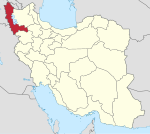Takab
Takab
تكاب، تیکان تپه | |
|---|---|
city | |
 | |
| Country | |
| Province | West Azerbaijan |
| County | Takab |
| Bakhsh | Central |
| Population (2006) | |
| • Total | 43,702 |
| Time zone | UTC+3:30 (IRST) |
| • Summer (DST) | UTC+4:30 (IRDT) |
Takāb or Tekāb (Persian: تكاب; also known as Azerbaijani: Tikan Təpə تیکان تپه)[1] is a city in and the capital of Takab County, West Azerbaijan Province, Iran. At the 2006 census, its population was 43,702, in 10,078 families.[2] The city's inhabitants are predominantly Iranian Azerbaijanis who speak the Azerbaijani language. The famous historical complex Takht-e Soleyman is situated to the North-East of the city. Takht-e-Soleyman was one of Takab's oldest Zoroastrian fire temples during the Sassanid Dynasty and had the name Azargoshnasp.[3] The Karaftu Cave is also situated in Takab near Saqqez.
Etymology
Shiz is the ancient name used during Persian Empire for Takab. Takab means one narrow water way in Persian language. Tak means one or alone and Ab means water. Takab was originally known as Tikan Təpə by its native Afshar people until 1941 when Iran's Academy of Persian Language and Literature officially changed it to Takab. Afshar people are one of the Oghuz Turkic peoples.[4] These originally nomadic Oghuz tribes moved from Central Asia and initially settled in Iranian Azerbaijan, Azerbaijan republic, and Eastern Turkey. Later some of them relocated by the Safavids to Khurasan and Mazandaran.[5] Today, they are variously grouped as a branch of the Turkmens[6] or the Azerbaijanis.[7]
Culture
Takab has long been one of the centers for production of the famous Afshar rugs. Weaving in Takab flourished in the Safavid era.
Notable people
- Shahriar Afshar: is an Iranian-American physicist and multiple award-winning inventor.
References
Notes
- ^ Takab can be found at GEOnet Names Server, at this link, by opening the Advanced Search box, entering "-3086724" in the "Unique Feature Id" form, and clicking on "Search Database".
- ^ "Census of the Islamic Republic of Iran, 1385 (2006)" (Excel). Statistical Center of Iran. Archived from the original on 2011-09-20.
- ^ Mohammadi,A (1997). History of Takab Afshar. Tehran: Eman press, Khorshidi: 1376.
- ^ Oberling, P. "AFŠĀR". Encyclopedia Iranica. Retrieved 9 July 2009.
AFŠĀR, one of the twenty-four original Ḡuz Turkic tribes
{{cite web}}: Cite has empty unknown parameters:|trans_title=,|month=, and|coauthors=(help) - ^ Iran's Diverse Peoples: A Reference Sourcebook, ed. Massoume Price, (ABC-CLIO, 2005), pp. 75, 89.
- ^ From multilingual empire to contested modern state, Touraj Atabaki, Iran in the 21st Century: Politics, Economics & Conflict, ed. Homa Katouzian, Hossein Shahidi, (Routledge, 2008), 41.
- ^ Richard V. Weekes. Muslim peoples: a world ethnographic survey. AZERI. — Greenwood Press, 1978 — p. 56 — ISBN 9780837198804

